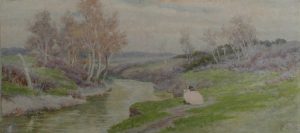Biography

FERRARI Hector, sculptor and painter (Rome 1845 – 1929). Son of Filippo, a discreet sculptor and of Maria Luisa Pasini descended from a noble Florentine family, after completing the university he devoted himself to artistic studies in the footsteps of his father. These, together with the first artistic teachings, had inculcated the principles of the republican faith that led him, at only 14 years, to run away from home to try to reach the Garibaldi expedition of the Thousand.
In 1868 he won the sculpture pensioner at the Accademia di San Luca (Albacini competition), where he continued his studies until 1972, also attending the nude school. Starting from these years he also approaches landscape painting, under the suggestion of the works of his father-in-law, the Swiss painter Johan Jakob Frey. The sculpture, however, remains at the top of his thoughts, with plastic works of a descriptive verism of romantic intonation (Jacopo Ortis, Ermengarda and Cum Spartaco pugnavi who earned him the prize at the Turin Exhibition of 1880). His sculptures of the main Risorgimento characters (especially Vittorio Emanuele II and Garibaldi) will gradually occupy the main squares in Italy.
But the imperishable fame is linked to two very famous Roman monuments: the one in Giordano Bruno in Piazza Campo dei Fiori and the one in Mazzini, built posthumously, at the Circus Maximus. Giovanni Spadolini rightly defines him as the statuary of the “Third Rome”, “the coherent interpreter of that left wing of the Risorgimento, summarized in the capital by the administrative experiences of the junta Nathan”.
However, since 1870 he begins to go to the Roman countryside to paint with Calandi; robust designer and refined watercolorist, although painting for his own entertainment (to the point of almost never signing his works) he was first part of the company In Arte Libertas by Nino Costa and then we find him among the founders of the XXV Group, jokingly renamed “L ‘golden eagle’ you want for his republican ideals, you want for his aquiline nose.
Convinced Freemason, he took an active part in the political life of the country (city councilor without interruption from 1877 to 1907 and member of parliament in the ranks of the radical party for two legislatures, 1882-1900). Even the initiatory career is full of satisfactions and sees him arrive in 1892 to the position of Venerable Master and then, in 1895, he became Grand Master of Italian Freemasonry. His participation in artistic life was also intense; the numerous positions held on the occasion of exhibitions and exhibitions make him a charismatic figure essential in the Italian artistic panorama.
In 1922 with all the other members of the group, he participated (seven watercolors and a pastel) in the famous collective of the XXV of the Roman countryside hosted within the XC annual exhibition organized in Rome by the Amateurs and Cultists of Fine Arts.
After the advent of fascism, from which he was persecuted for the aversion of the regime to the Masonic movement, he resigned from all public positions occupied. He died on August 19, 1929, mourned by the faithful old friends of the “XXV”, companions of many Sunday raids.